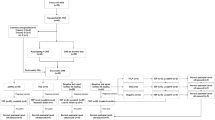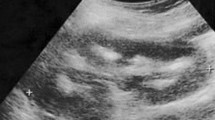Abstract
Background
Prenatal diagnosis of hyperechogenic kidneys is associated with a wide range of etiologies and prognoses. The recent advances in fetal ultrasound associated with the development of next-generation sequencing for molecular analysis have enlarged the spectrum of etiologies, making antenatal diagnosis a very challenging discipline. Of the various known causes of hyperechogenic fetal kidneys, calcium and phosphate metabolism disorders represent a rare cause. An accurate diagnosis is crucial for providing appropriate genetic counseling and medical follow-up after birth.
Methods
We report on three cases of fetal hyperechogenic kidneys corresponding to postnatal diagnosis of nephrocalcinosis. In all cases, antenatal ultrasound showed hyperechogenic kidneys of normal to large size from 22 gestational weeks, with a normal amount of amniotic fluid. Postnatal ultrasound follow-up showed nephrocalcinosis associated with hypercalcemia, hypercalciuria, elevated 1,25(OH)2-vitamin D, and suppressed parathyroid hormone levels.
Results
Molecular genetic analysis by next-generation sequencing performed after birth in the three newborns revealed biallelic pathogenic variants in the SLC34A1 gene, encoding the sodium/phosphate cotransporter type 2 (Npt2a), confirming the diagnosis of infantile hypercalcemia.
Conclusions
Nephrocalcinosis due to infantile hypercalcemia can be a cause of fetal hyperechogenic kidneys, which suggests early antenatal anomaly of calcium and phosphate metabolism. This entity should be considered in differential diagnosis. Postnatal follow-up of infants with hyperechogenic kidneys should include evaluation of calcium and phosphate metabolism.



Similar content being viewed by others
References
Chaumoitre K, Brun M, Cassart M, Maugey-Laulom B, Eurin D, Didier F, Avni EF (2006) Differential diagnosis of fetal hyperechogenic cystic kidneys unrelated to renal tract anomalies: a multicenter study. Ultrasound Obstet Gynecol 28:911–917
Yinon Y, Farine D, Yudin MH (2010) Cytomegalovirus infection in pregnancy. J Obstet Gynaecol Can 32:348–354
Tsatsaris V, Gagnadoux MF, Aubry MC, Gubler MC, Dumez Y, Dommergues M (2002) Prenatal diagnosis of bilateral isolated fetal hyperechogenic kidneys. Is it possible to predict long term outcome? BJOG 109:1388–1393
Ashton EJ, Legrand A, Benoit V, Roncelin I, Venisse A, Zennaro MC, Jeunemaitre X, Iancu D, Van't Hoff WG, Walsh SB, Godefroid N, Rotthier A, Del Favero J, Devuyst O, Schaefer F, Jenkins LA, Kleta R, Dahan K, Vargas-Poussou R, Bockenhauer D (2018) Simultaneous sequencing of 37 genes identified causative mutations in the majority of children with renal tubulopathies. Kidney Int 93:961–967
Richards S, Aziz N, Bale S, Bick D, Das S, Gastier-Foster J, Grody WW, Hegde M, Lyon E, Spector E, Voelkerding K, Rehm HL, ACMG Laboratory Quality Assurance Committee (2015) Standards and guidelines for the interpretation of sequence variants: a joint consensus recommendation of the American College of Medical Genetics and Genomics and the Association for Molecular Pathology. Genet Med 17:405–424
Schlingmann KP, Ruminska J, Kaufmann M, Dursun I, Patti M, Kranz B, Pronicka E, Ciara E, Akcay T, Bulus D, Cornelissen EA, Gawlik A, Sikora P, Patzer L, Galiano M, Boyadzhiev V, Dumic M, Vivante A, Kleta R, Dekel B, Levtchenko E, Bindels RJ, Rust S, Forster IC, Hernando N, Jones G, Wagner CA, Konrad M (2016) Autosomal-recessive mutations in SLC34A1 encoding sodium-phosphate cotransporter 2A cause idiopathic infantile hypercalcemia. J Am Soc Nephrol 27:604–614
Yeo G, Burge CB (2004) Maximum entropy modeling of short sequence motifs with applications to RNA splicing signals. J Comput Biol 11:377–394
Lapointe JY, Tessier J, Paquette Y, Wallendorff B, Coady MJ, Pichette V, Bonnardeaux A (2006) NPT2a gene variation in calcium nephrolithiasis with renal phosphate leak. Kidney Int 69:2261–2267
Daga A, Majmundar AJ, Braun DA, Gee HY, Lawson JA, Shril S, Jobst-Schwan T, Vivante A, Schapiro D, Tan W, Warejko JK, Widmeier E, Nelson CP, Fathy HM, Gucev Z, Soliman NA, Hashmi S, Halbritter J, Halty M, Kari JA, El-Desoky S, Ferguson MA, Somers MJG, Traum AZ, Stein DR, Daouk GH, Rodig NM, Katz A, Hanna C, Schwaderer AL, Sayer JA, Wassner AJ, Mane S, Lifton RP, Milosevic D, Tasic V, Baum MA, Hildebrandt F (2018) Whole exome sequencing frequently detects a monogenic cause in early onset nephrolithiasis and nephrocalcinosis. Kidney Int 93:204–213
Kaneko I, Tatsumi S, Segawa H, Miyamoto KI (2017) Control of phosphate balance by the kidney and intestine. Clin Exp Nephrol 21(Suppl 1):21–26
Magen D, Berger L, Coady MJ, Ilivitzki A, Militianu D, Tieder M, Selig S, Lapointe JY, Zelikovic I, Skorecki K (2010) A loss-of-function mutation in NaPi-IIa and renal Fanconi’s syndrome. N Engl J Med 362:1102–1109
Schlingmann KP, Kaufmann M, Weber S, Irwin A, Goos C, John U, Misselwitz J, Klaus G, Kuwertz-Broking E, Fehrenbach H, Wingen AM, Güran T, Hoenderop JG, Bindels RJ, Prosser DE, Jones G, Konrad M (2011) Mutations in CYP24A1 and idiopathic infantile hypercalcemia. N Engl J Med 365:410–421
Dinour D, Davidovits M, Ganon L, Ruminska J, Forster IC, Hernando N, Eyal E, Holtzman EJ, Wagner CA (2016) Loss of function of NaPiIIa causes nephrocalcinosis and possibly kidney insufficiency. Pediatr Nephrol 31:2289–2297
Dinour D, Beckerman P, Ganon L, Tordjman K, Eisenstein Z, Holtzman EJ (2013) Loss-of-function mutations of CYP24A1, the vitamin D 24-hydroxylase gene, cause long-standing hypercalciuric nephrolithiasis and nephrocalcinosis. J Urol 190:552–557
Figueres ML, Linglart A, Bienaime F, Allain-Launay E, Roussey-Kessler G, Ryckewaert A, Kottler ML, Hourmant M (2015) Kidney function and influence of sunlight exposure in patients with impaired 24-hydroxylation of vitamin D due to CYP24A1 mutations. Am J Kidney Dis 65:122–126
Pronicka E, Ciara E, Halat P, Janiec A, Wojcik M, Rowinska E, Rokicki D, Pludowski P, Wojciechowska E, Wierzbicka A, Książyk JB, Jacoszek A, Konrad M, Schlingmann KP, Litwin M (2017) Biallelic mutations in CYP24A1 or SLC34A1 as a cause of infantile idiopathic hypercalcemia (IIH) with vitamin D hypersensitivity: molecular study of 11 historical IIH cases. J Appl Genet 58:349–353
Gigante M, Santangelo L, Diella S, Caridi G, Argentiero L, D”Alessandro MM, Martino M, Stea ED, Ardissino G, Carbone V, Pepe S, Scrutinio D, Maringhini S, Ghiggeri GM, Grandaliano G, Giordano M, Gesualdo L (2016) Mutational Spectrum of CYP24A1 gene in a cohort of Italian patients with idiopathic infantile hypercalcemia. Nephron 133:193–204
Molin A, Baudoin R, Kaufmann M, Souberbielle JC, Ryckewaert A, Vantyghem MC, Eckart P, Bacchetta J, Deschenes G, Kesler-Roussey G, Coudray N, Richard N, Wraich M, Bonafiglia Q, Tiulpakov A, Jones G, Kottler ML (2015) CYP24A1 mutations in a cohort of hypercalcemic patients: evidence for a recessive trait. J Clin Endocrinol Metab 100:E1343–E1352
Ohata Y, Ozono K, Michigami T (2016) Current concepts in perinatal mineral metabolism. Clin Pediatr Endocrinol 25:9–17
Kovacs CS (2016) Maternal mineral and bone metabolism during pregnancy, lactation, and post-weaning recovery. Physiol Rev 96:449–547
Ma Y, Kirby BJ, Fairbridge NA, Karaplis AC, Lanske B, Kovacs CS (2017) FGF23 is not required to regulate fetal phosphorus metabolism but exerts effects within 12 hours after birth. Endocrinology 158:252–263
Sabbagh Y, O'Brien SP, Song W, Boulanger JH, Stockmann A, Arbeeny C, Schiavi SC (2009) Intestinal npt2b plays a major role in phosphate absorption and homeostasis. J Am Soc Nephrol 20:2348–2358
Caballero D, Li Y, Ponsetto J, Zhu C, Bergwitz C (2017) Impaired urinary osteopontin excretion in Npt2a−/− mice. Am J Physiol Renal Physiol 312:F77–F83
Funding
Funding for this study was in part provided by the European Union, FP7 (grant agreement 2012-305608) “European Consortium for High-Throughput Research in Rare Kidney Diseases (EURenOmics).”
Author information
Authors and Affiliations
Corresponding author
Ethics declarations
Conflict of interest
The authors declare that they have no conflict of interest.
Rights and permissions
About this article
Cite this article
Hureaux, M., Molin, A., Jay, N. et al. Prenatal hyperechogenic kidneys in three cases of infantile hypercalcemia associated with SLC34A1 mutations. Pediatr Nephrol 33, 1723–1729 (2018). https://doi.org/10.1007/s00467-018-3998-z
Received:
Revised:
Accepted:
Published:
Issue Date:
DOI: https://doi.org/10.1007/s00467-018-3998-z




